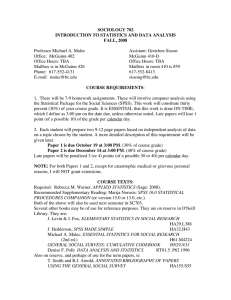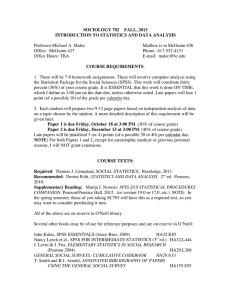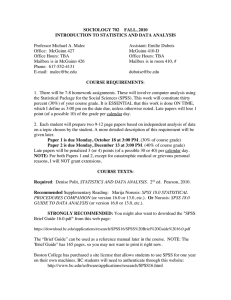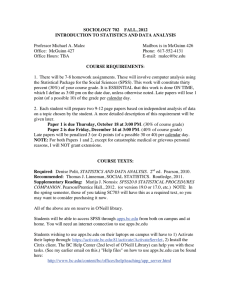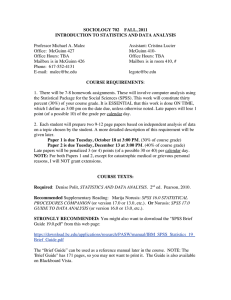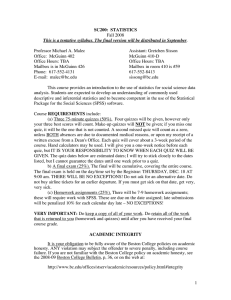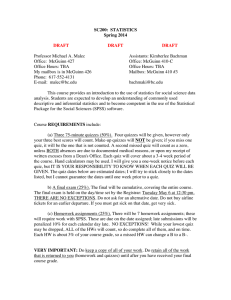SOCIOLOGY 702 INTRODUCTION TO STATISTICS AND DATA ANALYSIS Professor Michael A. Malec
advertisement
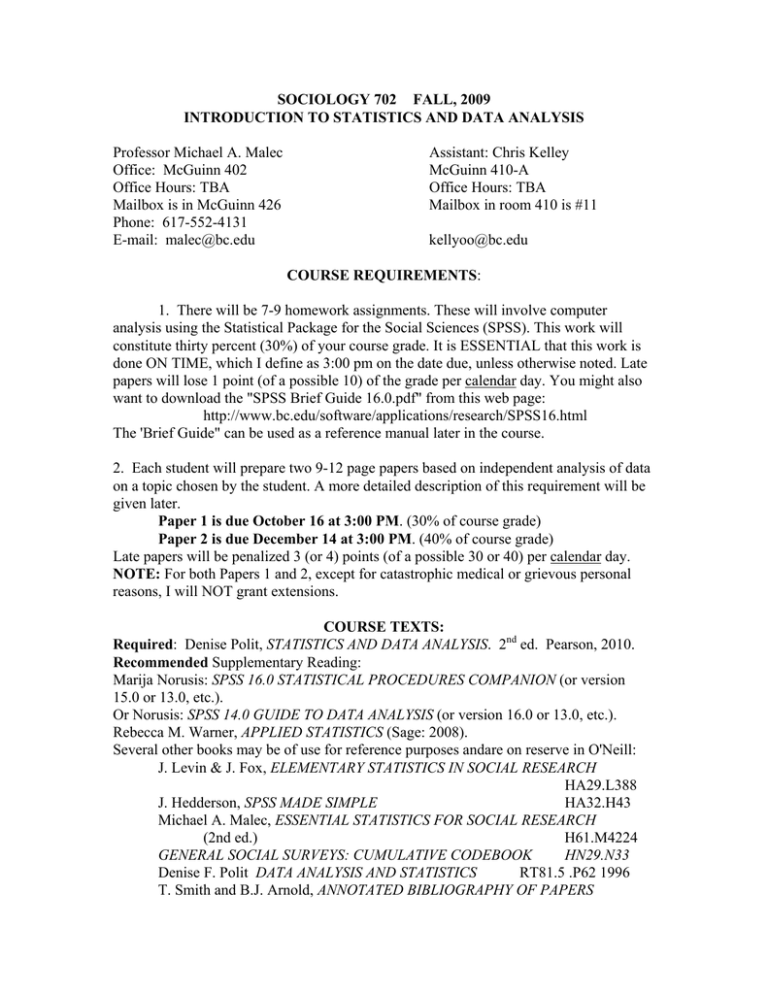
SOCIOLOGY 702 FALL, 2009 INTRODUCTION TO STATISTICS AND DATA ANALYSIS Professor Michael A. Malec Office: McGuinn 402 Office Hours: TBA Mailbox is in McGuinn 426 Phone: 617-552-4131 E-mail: malec@bc.edu Assistant: Chris Kelley McGuinn 410-A Office Hours: TBA Mailbox in room 410 is #11 kellyoo@bc.edu COURSE REQUIREMENTS: 1. There will be 7-9 homework assignments. These will involve computer analysis using the Statistical Package for the Social Sciences (SPSS). This work will constitute thirty percent (30%) of your course grade. It is ESSENTIAL that this work is done ON TIME, which I define as 3:00 pm on the date due, unless otherwise noted. Late papers will lose 1 point (of a possible 10) of the grade per calendar day. You might also want to download the "SPSS Brief Guide 16.0.pdf" from this web page: http://www.bc.edu/software/applications/research/SPSS16.html The 'Brief Guide" can be used as a reference manual later in the course. 2. Each student will prepare two 9-12 page papers based on independent analysis of data on a topic chosen by the student. A more detailed description of this requirement will be given later. Paper 1 is due October 16 at 3:00 PM. (30% of course grade) Paper 2 is due December 14 at 3:00 PM. (40% of course grade) Late papers will be penalized 3 (or 4) points (of a possible 30 or 40) per calendar day. NOTE: For both Papers 1 and 2, except for catastrophic medical or grievous personal reasons, I will NOT grant extensions. COURSE TEXTS: Required: Denise Polit, STATISTICS AND DATA ANALYSIS. 2nd ed. Pearson, 2010. Recommended Supplementary Reading: Marija Norusis: SPSS 16.0 STATISTICAL PROCEDURES COMPANION (or version 15.0 or 13.0, etc.). Or Norusis: SPSS 14.0 GUIDE TO DATA ANALYSIS (or version 16.0 or 13.0, etc.). Rebecca M. Warner, APPLIED STATISTICS (Sage: 2008). Several other books may be of use for reference purposes andare on reserve in O'Neill: J. Levin & J. Fox, ELEMENTARY STATISTICS IN SOCIAL RESEARCH HA29.L388 J. Hedderson, SPSS MADE SIMPLE HA32.H43 Michael A. Malec, ESSENTIAL STATISTICS FOR SOCIAL RESEARCH (2nd ed.) H61.M4224 GENERAL SOCIAL SURVEYS: CUMULATIVE CODEBOOK HN29.N33 Denise F. Polit DATA ANALYSIS AND STATISTICS RT81.5 .P62 1996 T. Smith and B.J. Arnold, ANNOTATED BIBLIOGRAPHY OF PAPERS USING THE GENERAL SOCIAL SURVEY HA155.S55 SC702 Syllabus, Fall, 2009 TOPICS AND READINGS Dates are subject to change Additional topics may be added as time allows 1. INTRODUCTION; USING SPSS (Week of Sept. 8) Objectives: to learn some of the basics of SPSS programming; to submit an SPSS run. Reading: Handouts as assigned or distributed; Polit, Chs. 1-2 ; Warner, Chs. 1-2, and 4; Norusis Guide 14.0, Cs. 1-2; Norusis Companion 16.0, Chs. 1-2 and 7 2. DESCRIPTIVE STATISTICS (Sep. 15, 22) Objectives: to be able to use, and interpret the output of, the FREQUENCIES and DESCRIPTIVE procedures in SPSS. Topics Considered: level of measurement (nominal, ordinal, interval, ratio), histograms, measures of central tendency, measures of dispersion, percentiles, Z scores, mean, median, mode, variance, standard deviation, standard error, skewness, range, the normal distribution. Other topics as deemed appropriate. Reading: Polit, Chs. 3 and 5; Warner, Chs. 1, 2, and 4; Norusis Guide Ch. 5; Norusis Companion, Chs 3-6 and 10; Levin & Fox (L&F), Chs. 1-6 (esp. 5 and 6); Malec, Chs. 1-4 3. DIFFERENCES IN MEANS (Sept. 29, Oct. 6, 13, 20) Objectives: to be able to use, and interpret the output of, the T-TEST and ONEWAY procedures. Topics Considered: probability; sampling distribution, samples vs populations, simple random samples vs other types of samples; the research hypothesis, the null hypothesis, directional vs nondirectional research hypotheses; alpha and the critical region; Type I vs Type II error; statistical significance vs substantive significance, sampling distribution of the mean, confidence intervals, one-tailed vs two-tailed tests; the t-test; equal (or pooled) 2 variance estimate vs unequal (or separate) variance estimate; simple one-way analysis of variance. Other topics as deemed appropriate. SC702 Syllabus, Fall, 2009 Reading: Polit, Chs. 6-7; Warner, Chs. 3, 5 and 6; Norusis Guide Cha. 10-14; Norusis Companion, Chs. 79; L&F, Chs. 10 and 11; Malec, Ch. 7 NOTE: Paper 1 is due Friday, October 16 at 3:00 PM (30% of course grade). Late papers will be penalized 3 points (of a possible 30) per calendar day. 4. CROSSTABULATION & MEASURES OF ASSOCIATION (Oct. 27, Nov. 3, 10) Objectives: to be able to use, and interpret the output of, the CROSSTABS procedure, to understand the distinction between a measure of association and a test of significance, to understand the concept of statistical inference and the uses and misuses of tests of significance. Topics Considered: measures of association (nominal measures, Chi-Square, PRE measures, ordinal measures; the elaboration paradigm (explanation, interpretation, specification, spurious relationships, suppresser variables); main and interaction effects in crosstabs tables. Other topics as deemed appropriate. Reading: Polit, Ch. 8 (to p. 178 only); Warner, Ch. 8 and section 10.12; Norusis Guide Ch. 17 to p. 377), 18 (pp. 400402) and19; Norusis Companion, Ch. 10 (also 447-451); Malec, Ch. 8, 9 (pp. 137-154), 11 (pp. 184-193); L&F, Chs. 7-9, 12, and 13 (pp. 330-354) 5. PEARSON CORRELATION COEFFICIENT (r), PARTIAL CORRELATION, SCATTERPLOTS, AND SIMPLE REGRESSION (Nov. 17, 24, Dec. 1 ) Nov. 26 is Thanksgiving – no class. Objectives: to be able to use, and interpret the output of, the CORRELATIONS and PARTIAL CORR procedures. Topics Considered: the Pearson correlation coefficient, R-square, slope, intercept, the equation for a regression line, predicted value vs actual value, standard error of estimate, 3 use and interpretation of scattergrams, partial correlation, higher order partials. Other topics as deemed appropriate. SC702 Syllabus, Fall, 2009 Reading: Polit, Ch. 9; Warner, Ch. 7, 9 and 10.1-10.11, also skim Ch. 11; Norusis Guide Ch. 20; Norusis Companion Chs. 11-12 and pp. 237-254; L&F Ch. 13 (to p. 330); Malec, Ch. 9 (pp. 154-158), 10, 11 (pp. 189-192) 6. NONPARAMETRIC TESTS (Dec. 8) Objectives: to be able to use, and interpret the output of, the NONPAR TESTS and NONPAR CORR procedures Topics Considered: Spearman's rank correlation coefficient, Mann-Whitney test (and others as time allows). Other topics as deemed appropriate. Reading: Polit, Ch. 8 (pp. 178-194); ; Norusis Companion, Ch. 19; Paper 2 is due Monday, December 14 at 3:00 PM (40% of course grade). Late papers will be penalized 4 points (of a possible 40) per calendar day. ACADEMIC INTEGRITY It is your obligation to be fully aware of the Boston College policies on academic honesty. ANY violation may subject the offender to severe penalty, including course failure. If you are not familiar with the Boston College policy on academic honesty, see the 2008-09 Boston College Bulletin, p. 36, or on the web at: http://www.bc.edu/offices/stserv/academic/resources/policy.html#integrity You might also want to download the "SPSS Brief Guide 16.0.pdf" from this web page: http://www.bc.edu/software/applications/research/SPSS16.html The 'Brief Guide" can be used as a reference manual in the course. 4 5
